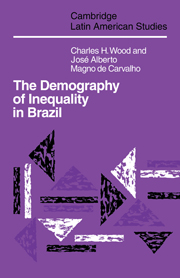Book contents
- Frontmatter
- Contents
- Illustrations
- List of tables
- Preface
- 1 Introduction
- 2 Framework for the study of population, development and inequality
- 3 Growth and distribution in historical perspective
- 4 Income inequality and length of life
- 5 Wage policy, infant mortality and collective social action in São Paulo
- 6 Racial inequality and child mortality
- 7 The “baby bust”
- 8 Income distribution and population growth
- 9 Agrarian structure and the rural exodus
- 10 Colonization and frontier expansion in Amazônia
- 11 Development and persistent underemployment
- 12 The demography of inequality in Brazil: summary and conclusion
- Appendix: A note on method
- Notes
- Bibliography
- Index
- CAMBRIDGE LATIN AMERICAN STUDIES
1 - Introduction
Published online by Cambridge University Press: 04 August 2010
- Frontmatter
- Contents
- Illustrations
- List of tables
- Preface
- 1 Introduction
- 2 Framework for the study of population, development and inequality
- 3 Growth and distribution in historical perspective
- 4 Income inequality and length of life
- 5 Wage policy, infant mortality and collective social action in São Paulo
- 6 Racial inequality and child mortality
- 7 The “baby bust”
- 8 Income distribution and population growth
- 9 Agrarian structure and the rural exodus
- 10 Colonization and frontier expansion in Amazônia
- 11 Development and persistent underemployment
- 12 The demography of inequality in Brazil: summary and conclusion
- Appendix: A note on method
- Notes
- Bibliography
- Index
- CAMBRIDGE LATIN AMERICAN STUDIES
Summary
Brazil is the largest and most populous country in Latin America. In 1980, the census bureau counted nearly 120 million people, a figure more than twice that of second-ranked Mexico. Brazil's 8.5 million square kilometers of national territory stretch from the Atlantic Ocean in the east to the foothills of the Andes in the west; from the Guiana plateau in the north to the Plate River basin in the south. The country's continental proportions dominate the geopolitical map of the southern hemisphere, making it the fifth largest country in the world, surpassed in area only by the Soviet Union, the United States, China and Canada.
In the nineteenth century, the change from colony to independent empire (1822), from monarchy to republic (1889–91) and from slaveholding society to a free one (1888) occurred essentially without violence. Brazil's early history thus imparted to the country a legacy of political stability and national unity rare in the New World (Burns 1970). Unlike many of its neighbors in the continent, direct military control of the state has been the exception in Brazil. From the late 1800s through the first three decades of the twentieth century, Brazil's presidents were duly elected. The democratic tradition was interrupted in the period 1930–4 and again in 1937–45 when Getulio Vargas, a civilian backed by the military, ruled by decree.
- Type
- Chapter
- Information
- The Demography of Inequality in Brazil , pp. 1 - 11Publisher: Cambridge University PressPrint publication year: 1988



